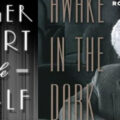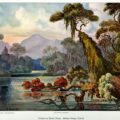An Attention to What Continues: Two Books on Herbaria

George W. Clinton (1807-1885) was a lawyer and judge, as well as the first Democratic mayor of Buffalo, New York. But his true passion was botany. He spent many hours exploring Buffalo and its environs, collecting plants, pressing and mounting them on archival paper, and assembling them into a personal herbarium that eventually included more than 25,000 specimens. Clinton was part of an extensive network of botanists, both amateur and professional, who collected and exchanged botanical specimens from all parts of the United States. Among his correspondents was the renowned botanist Asa Gray, who named a species of sedge Clinton’s bulrush (Trichophorum clintonii) in his honor. As the result of his exchanges with other botanists, the specimens collected by Clinton now reside in herbaria all across North America. There are more than 600 in the collection of the New York Botanical Gardens. Others form the basis of the botanical collection of the Buffalo Museum of Science, which Clinton helped to found in 1866.
It wasn’t just men like Clinton who were collecting plants and creating herbaria in the mid-19th century. The collection, mounting, and exchange of botanical specimens was taking place even among schoolchildren—like fourteen-year-old Una Hawthorne, who made a herbarium of plants collected during her family’s stay in Italy in 1858, and fifteen-year-old Emily Dickinson, who collected plants in the vicinity of Amherst and South Hadley, Massachusetts. In May 1845, Dickinson wrote to her friend Abiah Root: “Have you made an herbarium yet? I hope you will if you have not, it would be such a treasure to you; ’most all the girls are making one. If you do, perhaps I can make some addition to it from the flowers growing around here.” In another letter, she mentions that, because so many girls were collecting flowers for their herbaria, she found it necessary to venture farther afield to find good specimens.
Emily Dickinson’s personal herbarium now resides in Harvard’s Houghton Library. Although most of her specimens are labeled with the correct scientific name, the plants are not arranged according to genus or any other discernible scientific criterion. They seem to be placed more for artistic effect, or based on associations known only to Dickinson herself. On the page, her arrangements of plants are like her poems—striking images and unexpected juxtapositions, simplicity and mystery.
The story of herbaria—from their origins in the collection of the sixteenth-century Italian physician Luca Ghini in Bologna to modern virtual herbaria on the internet—is told in Herbarium: The Quest to Preserve and Classify the World’s Plants (Timber Press 2020),a lavishly-illustrated coffee table book for botanophiles by Barbara M. Thiers, the director of the William and Lynda Steere Herbarium at the New York Botanical Garden.
The book is full of remarkable stories of plant collectors such as Jeanne Baret, a skilled herbalist who disguised herself as a man to accompany her lover, botanist Philibert Commerson, on de Bougainville’s voyage of exploration to the South Pacific in 1765. In the process she became the first recorded woman to circumnavigate the globe. And there’s Alice Eastwood, collector and curator at the California Academy of Sciences, who risked her life to save the specimens from the Academy’s herbarium after the San Francisco earthquake of 1906. As fire closed in from surrounding buildings, Eastwood entered the ruined Academy, climbed the bannister of the ruined staircase, and lowered botanical specimens from a sixth story window. There is an abundance of material in the history of herbaria to engage the imagination of a novelist.
Helen Humphreys lives a short drive from the Fowler Herbarium at Queen’s University in Kingston, Ontario. A novelist and poet, she arranged to spend the year in residence at the herbarium, exploring the collection in evolutionary order from ferns to flowering plants. The result of that year-long exploration of the herbarium is Field Study: Meditations on a Year at the Herbarium (ECW Press 2021). The book is a quick read, but it invites deep reflection on our relationship to the natural world, on the things we have lost, and on what remains.
As a novelist, Humphreys is interested in the stories she finds filed away in the metal cabinets of the Fowler Herbarium. Each dried plant specimen is fragmentary evidence of a life—the life of the plant and the life of the collector—spent in nature. As she moves through the herbarium, she uncovers biographical information about the collectors that she records in brief vignettes, sometimes no more than a sentence or two, occasionally accompanied by a photograph of a specimen or a label associated with the collector. She occasionally finds brief accounts of the circumstances of time and place in which a specimen was collected: a date, a place, a brief, suggestive detail like “on the edge of a winter pond” that reads like a fragment of poetry.
Humphreys doesn’t spend much time on Emily Dickinson’s herbarium, but she devotes a section near the end of the book to Thoreau’s collection, which he very likely created with the help of his sister Sophia. Like the specimens in Dickinson’s herbarium, Thoreau’s specimens are arranged for greatest “visual appeal.” For Thoreau, a tree can be “full of poetry,” and his herbarium is a kind of transcription of the poetry of nature. Sophia Thoreau, Humphreys reminds us, once picked leaves from a shagbark hickory tree, pressed and dried them, and inscribed them with stanzas from one of her brother’s poems. Humphreys has an eye for these moments when the dried plants of the herbarium are reanimated with the spirit of poetry.
Through her collection of short anecdotes and descriptions, with an occasional longer excursus into something that especially appeals to her imagination, Humphreys recreates the experience of sifting through the herbarium, attempting to find patterns and to create meaning out of the exhausting wealth of material. Despite their overwhelming sameness, Humphreys especially appreciates the grasses because “they keep their form and colour and do not look very different in death than they did in life.” She continues:
Sometimes they have been glued down on their pieces of archival paper in imitation of how they bend with the wind. I’m not sure if this is accidental or purposeful on the part of the collector, of the person doing the mounting, but I like the arc of 150-year-old rushes on the page, as though they were preserved in the exact moment of bowing to the breeze.
The grasses offer a suggestion of life, and this is what appeals most to Humphreys about the herbarium. “I cannot think of another place where it is possible to look into the past and see the moment an orchid was plucked or a willow frond was cut from a branch.” The herbarium is to Humphreys a collection of these preserved moments—moments of heightened attention and of connection between a human being and the natural world.
Because Humphreys is suggestive rather than exhaustive, she leaves room for her readers to follow their own imaginations, gesturing at side paths through the material she presents. “I want to show how exploring an archive can be a journey,” she writes, “as thrilling as any taken in an actual landscape, and that no two journeys are alike… Another researcher or writer would choose a different direction.” Not everyone has a local herbarium to explore in person, and fewer still might spend their precious free time on such an excursion. Luckily, there are numerous virtual herbaria accessible online, including the William and Lynda Steere Herbarium at the New York Botanical Gardens. There is also a wealth of information on many of the collectors, including correspondence, available online at the Biodiversity Heritage Library.
In her section on grasses, Humphreys devotes four sentences to George W. Clinton, the Buffalo mayor, who died of a heart attack while collecting plants in a rural cemetery near Albany. She ends her brief account: “He was buried holding the clover that had been in his hand when he died.” In the Biodiversity Heritage Library, I found a letter from Clinton to Asa Gray (February 11, 1864), commenting on a recent scientific paper by Gray, that hints at Clinton’s personal connection to the plants he collected:
Think of it! I had pictured Gray, the great Botanical Gray, as, in his scientific investigations, a cold, severe, exact man of Science: and now—O horror!—I find him, in these very ‘Contributions,’ in this purely scientific paper, in his account of Oxytropis multiceps, —how shall I write it!—mentioning it as ‘this most rare and charming little alpine species!!!!!’ I am surprised, delighted, charmed… But I insist that this O. multiceps—charming though it be—cannot be more charming than hundreds of less regarded things with which I am familiar. For instance, —in a small package of grasses I sent you lately—what I want to, but dare not call Aira caespitosa. Whatever it may be it is a rare beauty.”
I found myself charmed myself by this man who, in a letter to the preeminent American botanist of the 19th century, writes about the charm of familiar plants and his affection for “the less regarded things.” While some readers may look for more synthesis of the varied material Humphreys presents, a more orderly and systematic approach may not have led me to Clinton and his delight. Like so many herbaria, its idiosyncrasies are also its charm.
In the New York Botanical Garden’s virtual herbarium there is a specimen of Deschampsia cespitosa—Clinton’s Aira caespitosa—that Clinton himself collected in Erie County, New York. There’s also a specimen that he collected of the plant Asa Gray named after him: Clinton’s bulrush. The specimen, as Humphreys observes of other grasses, appears to be swaying gently in a light breeze.
Clinton’s bulrush is currently rare and threatened due to fragmentation and loss of habitat. One of the values of a herbarium, as Barbara Thiers explains, is that it can track both loss and change—northward shifts in population and earlier bloom dates as the planet warms, the spread of naturalized and invasive species, fluctuations in environmental pollution. Well-labeled specimens in a herbarium can indicate where rare species like Clinton’s bulrush have flourished in the past and under what conditions they might be protected or reintroduced.
There is a wealth of information in the herbarium, and so much has been preserved there, but the cumulative effect of Humphreys’ botanical and biographical collection is fragmentation and loss. In a longer section in the middle of the book, Humphreys writes about the last walk she took with her dog Charlotte before Charlotte’s death, at a time when summer was at its fullest. She finds it harder to hold onto the memory of that last “beautiful walk through the middle of summer” as autumn sets in and the plants of that summer afternoon fade. The moment passes, like all the moments when someone collected a living plant that became a dried specimen in the herbarium.
“Even the wallow, where there is still an imprint of one of her paws, has dried out and filled in with the stiff bristle of field grasses.”
One of the most significant losses that Humphreys attests to is the absence from the herbarium of Indigenous plant names and knowledge. She finds one or two rare examples of a collector who has an ethnobotanical bent and records an Indigenous plant name, but she remains acutely aware as she sifts through the pages of the herbarium that collecting in the 19th century especially was a practice of settler colonialism, as men and women of European descent “discovered,” took possession of, and named plants which undoubtedly were long familiar to the indigenous people who had lived on the land for generations. The Seneca, whose ancestral land included Buffalo and its vicinity, must have had their own name for Clinton’s bulrush.
“It is true,” Barbara Thiers says, “that many times plant and fungal collection has been fueled by imperialism. The impulse to kill these organisms just to store them in cabinets may seem to derive from some base hoarding instinct.” But for the most part, Thiers highlights the generosity at work in the making of herbaria. “Herbaria may highlight one of our better human impulses: to save things for the future, not just for ourselves but for generations to come.”
It is this sense of continuance that Humphreys took away from her own exploration of the herbarium. “The process was comforting, reliable, at a time when I was feeling, more often than not, sad and adrift.” The herbarium came to seem hopeful. “We can’t merely focus on what is gone or disappearing,” she writes. “We also need to pay attention to what continues.”
About Rob Hardy
Rob Hardy has been a stay-at-home father, a teacher, a researcher for The Writers’ Almanac, a school board member, and an adult advisor to the Northfield Skateboard Coalition. His essays have appeared in New England Review, North Dakota Quarterly, New Letters, and other literary and scholarly journals. His poetry has appeared in literary journals, and has been stamped onto the sidewalks of Northfield, Minnesota. His translations and adaptations of Greek tragedy have been staged at Carleton College, where he’s currently a visiting assistant professor of classics.





